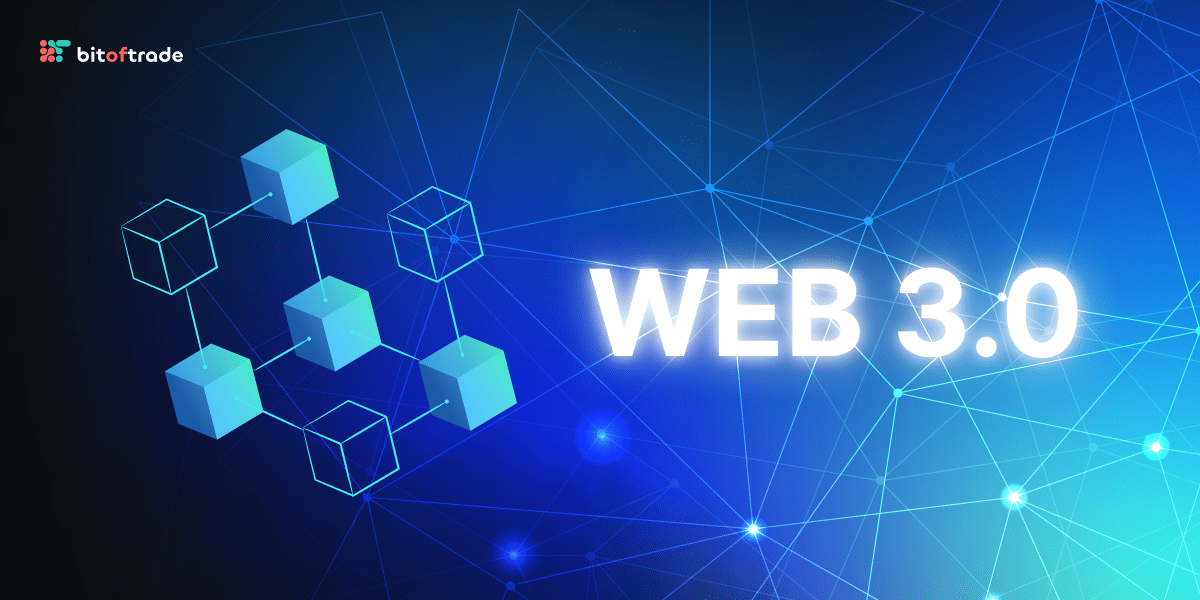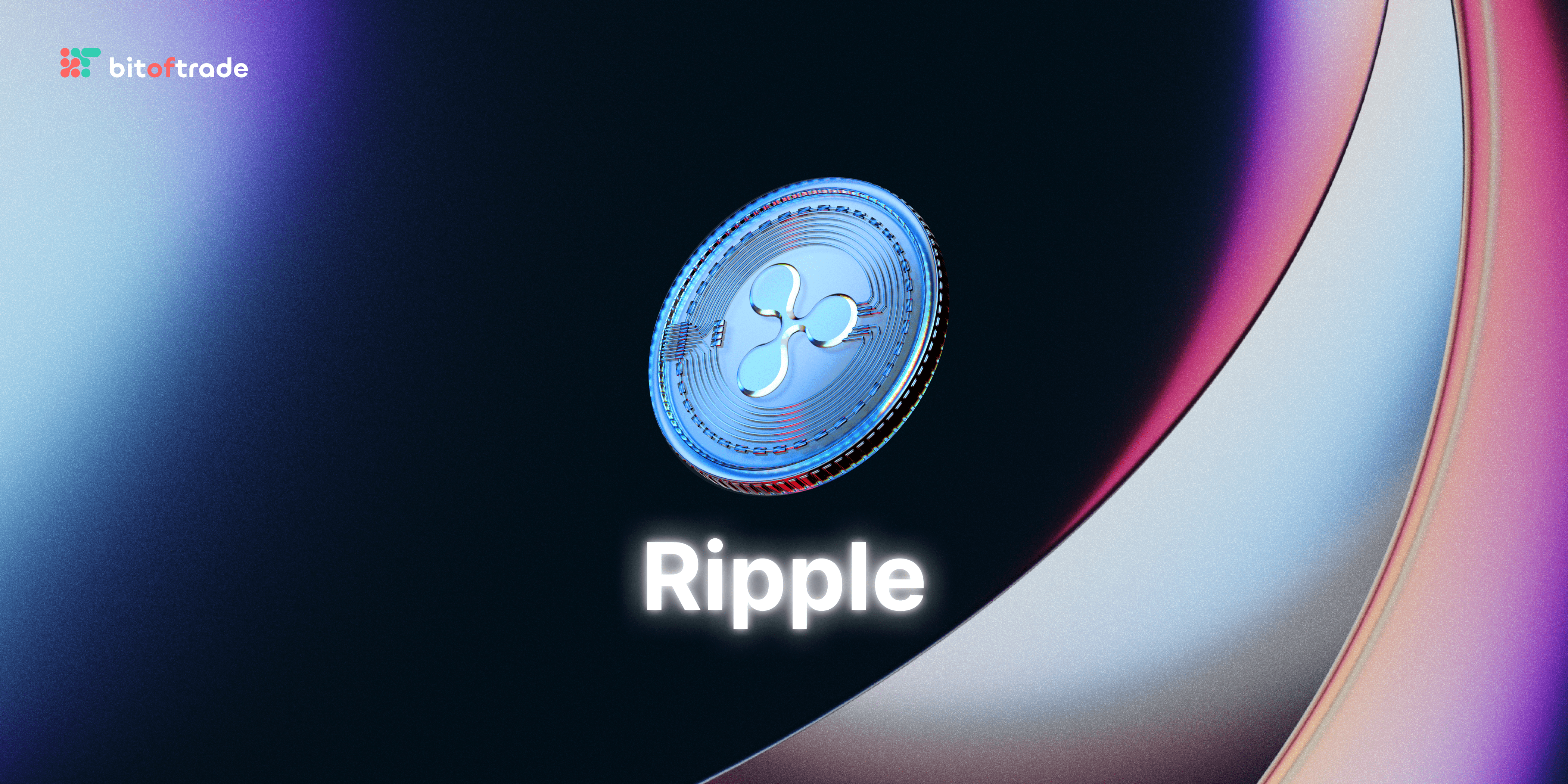Web 3.0 meaning
Web 3.0 is a term that came into our vocabulary at a time when it became clear that the Internet we were used to had changed as blockchain technology brought new ways of economic and social interaction.
Web 3.0 is not just cryptocurrencies and NFTs or newfangled P2E games. The next generation Internet aims to reshape the ways of building social networking, web browsers, data storages, video hostings and more in a transparent and decentralized way.
Among the many diverse and dissimilar Web 3.0 projects, one can distinguish such as Theta, which is a YouTube-like decentralized video distribution platform, Chromium-based Brave Browser which integrates with dApps and DeFi, ySign which is a blockchain-based messenger for discreet conversations with complete privacy.
In this article, we will try to explain what elements are included in the architecture of new blockchain projects, and using examples, we will consider how Web 3.0 applications and services can be useful for each of us.
But let's start with the basics: what preceded Web 3.0?
Web 1.0, Web 2.0, Web 3.0 explained
In 2005, Tim O'Reilly published an article on Web 2.0, which can be considered the beginning of thinking about the changes in digital interaction as changing eras. After O'Reilly's highlighting the unique features of Web 2.0, researchers began to distinguish three periods of the Internet's development:
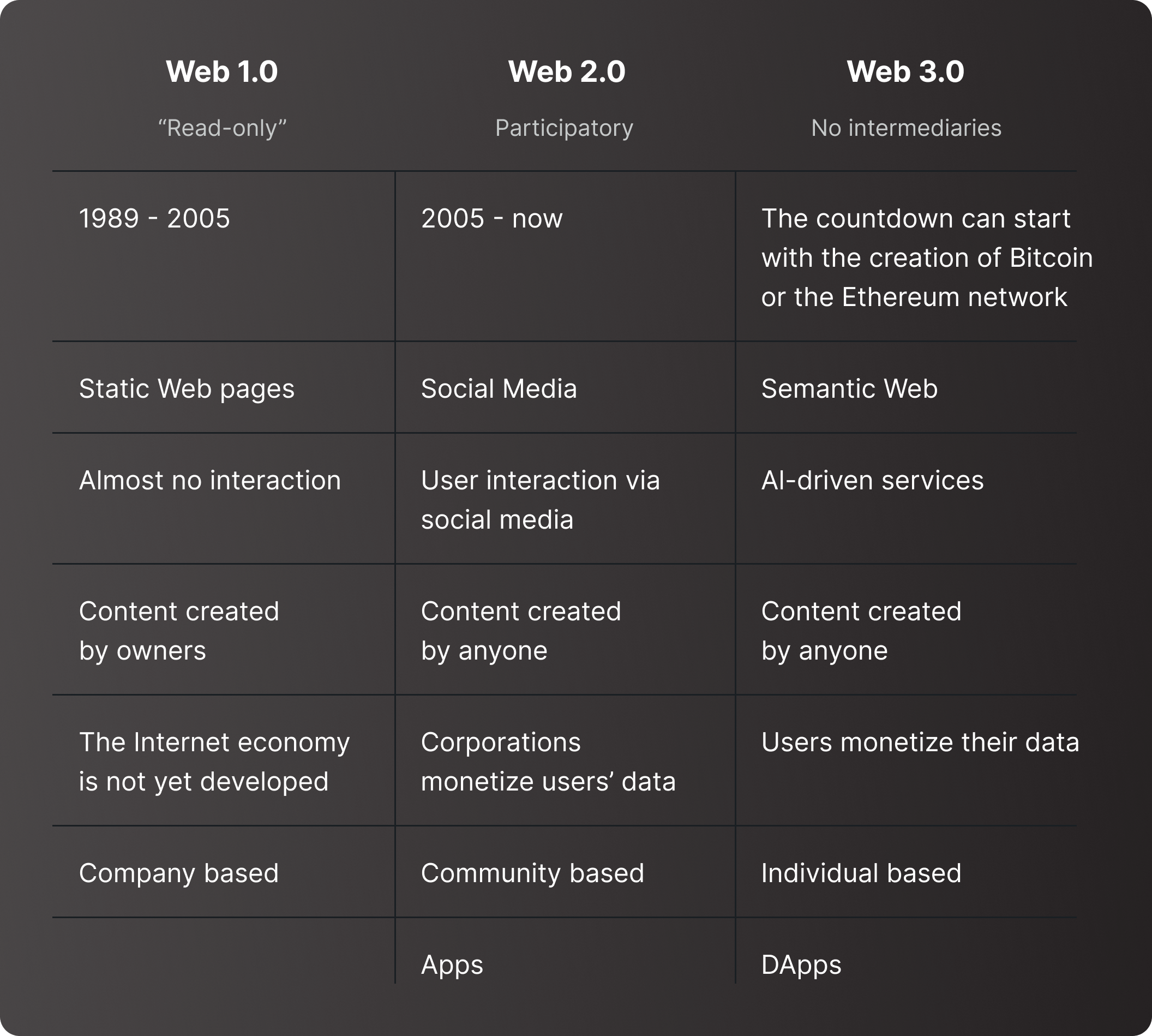
Web 1.0 (1989 – 2004) is the Internet, commonly called Read-only. Computers communicate with computers. There are no centralized storage bases, it means that users download and store information on a hard drive. There are no servers, no social networks, no authorization and logins, and no digital communication that we know now. Web 1.0 is a great digital library.
When the number of Internet users and the amount of data grows, there is a need to store massive amounts of data in one place 24/7. So, the centralized servers appear, and users lose control over personal data.
Web 2.0 (2004 – present) is the era of social networking and search queries, where the user cannot avoid registering and providing personal information in exchange for products and services. In the Web 2.0, companies are not only collecting users' data but also selling it to contextual advertising services like Google Ads. Web 2.0 becomes an era of targeted advertising and a lack of privacy, with economic interests taking precedence over individual interests.
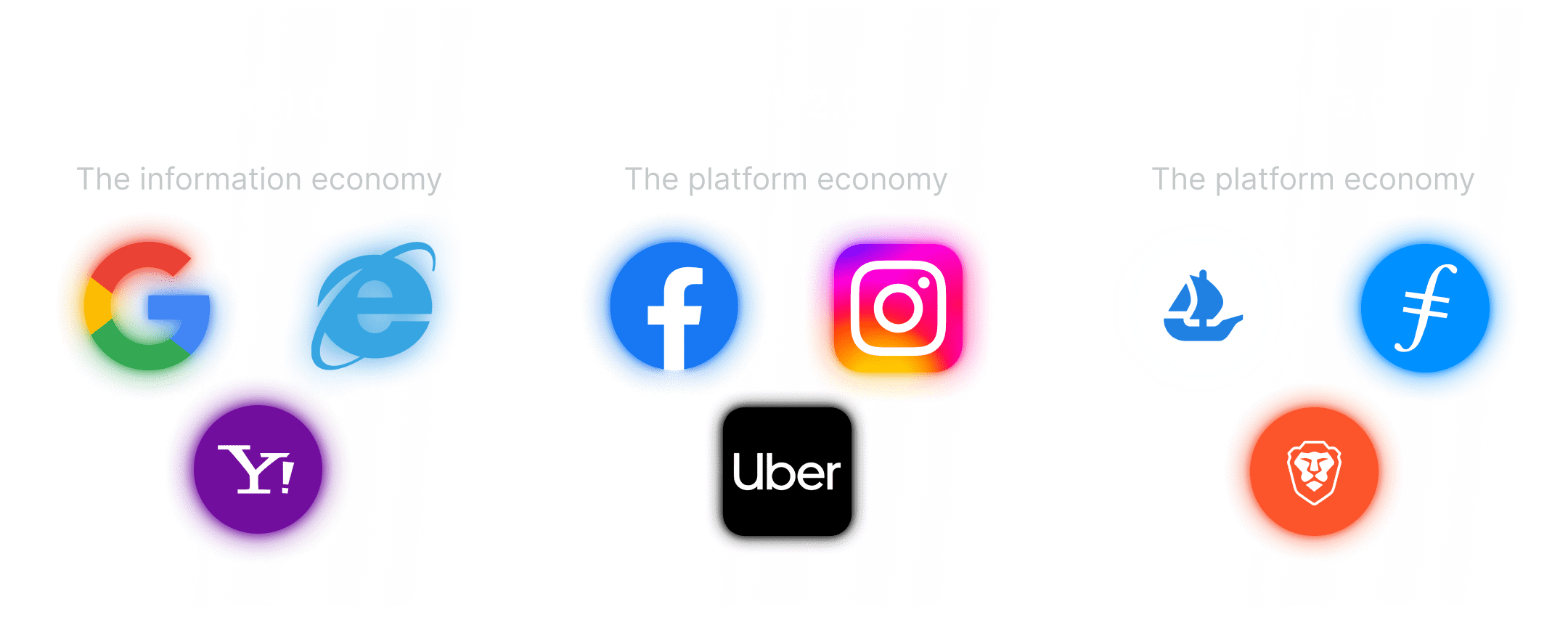
Therefore, Web 3.0 is coming, trying to change the financial system and the way people and institutions interact.
Learning Web 3.0
The third generation of the internet is powered by blockchain technology, cryptocurrencies, and non-fungible tokens (NFTs). Web 3.0 is not controlled by any single entity, so it turns out to be more transparent, secure, decentralized, and censorship-resistant.
In Web 3.0, users own their data, which also means they are free to sell and trade data or crypto assets without the risk of losing privacy or relying on third parties.
Let’s name the features of Web 3.0:
Web3 is self-governing. It means there is no single decision-making entity but a decentralized automated organization (DAO) - a set of users who manage this or that Web3 project.
Web3 is transparent. It means that anyone can double-check and validate the information written on the blockchain.
Web3 is trustless. It means it operates using math algorithms instead of relying on third parties.
Web3 is decentralized. It means that all the users’ data and personal accounts are controlled by users, not by centralized corps entities.
Web3 is permissionless. It means that everyone can equally participate in Web3.
Web 3.0 is cross-platform, which means that a user with a unique blockchain address can use it, keeping all their funds and data in different dApps and on decentralized platforms.
In the end, cryptocurrencies, decentralized exchanges, and non-custodial wallets are becoming an important element of Web3. Together, all this allows the user not to interact with traditional banks that have complete control over customer funds.
Components of Web 3.0 apps
Unlike in Web 2.0, the databases and servers of Web 3.0 are not centrally located. Here are the required components to create a Web 3.0 application: a blockchain, a smart contract, an Ethereum Virtual Machine (EVM), and a front-end.
Blockchain technology is a state machines that are maintained by a peer-to-peer network of nodes. Due to a large number of nodes, the independence of the data stored on the blockchain is preserved. One company or, say, a coalition of companies cannot change, block, or steal information because copies are stored on thousands of other users' computers.
A smart contract is a digital protocol used on the Ethereum blockchain and contains information about ongoing transactions. Smart contracts are created using mathematical cryptographic algorithms. All of today’s DeFi is built with smart contracts.
The Ethereum Virtual Machine is needed to run smart contracts. The EVM is a virtual computer on which all the nodes of the Ethereum network agree to run.
The front-end is the final component of the Web 3.0 software architecture. It defines the UI logic that is focused on communication with smart contracts (decentralized programs).
Web 3.0 examples
Filecoin is a decentralized storage for audio files, videos, images, or text.
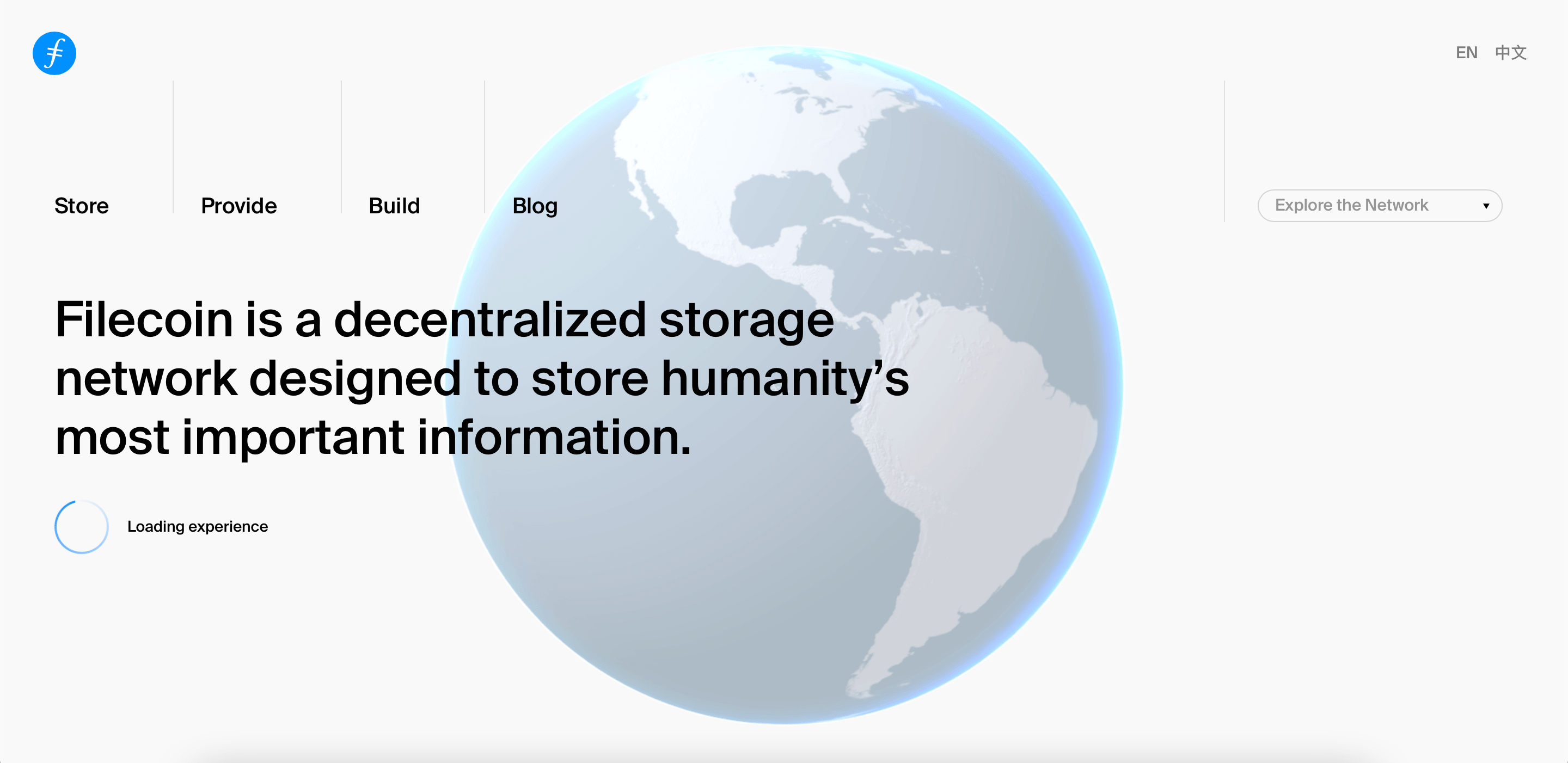
We can say that Filecoin is one of the biggest projects in the cloud storage industry. Capitalization of this industry is gaining momentum every year. So, it is reported that the industry can cross the threshold of $222.25 billion in 2027.
Let’s explore this blockchain-based solution.
Filecoin is a decentralized peer-to-peer marketplace for data storage and retrieval. Filecoin uses InterPlanetary File System (IPFS) blockchain for backend storage. IPFS is a storage hub used for storing and sharing data in a distributed file system.
Filecoin was established in 2017 and launched in 2020. The developer company Protocol Labs built the mainnet around a proof-of-storage consensus mechanism that includes Proof-of-Replication (PoRep) and Proof-of-Spacetime (PoSt) to validate operations on the network. Proof-of-replication is a process when a miner proves that he has kept a unique set of data in his storage. The proof-of-space-time is when storage providers show that data has been in storage for a specific time. These procedures are required to ensure that all the data remains unchanged and available on the network.
The network feature is that the user can store data with many separate providers depending on their cost, redundancy, and speed. The user pays FIL token to rent storage space for miners to host their files.
The network includes miners who store data and maintain the blockchain and storage providers offering storage space on their servers. There are two types of network miners: storage miners and retrieval miners. Storage miners earn FIL by mining and storage rents, while retrieval miners earn Filecoin when clients request retrieval and want to download files stored on the network. It is noteworthy that storage miners are encouraged even if their storage is not being used. Here is how Filecoin motivates members to stay inside the network. Miners receive rewards for their contributions to the network, such as storage fees and block rewards.
The strength of Filecoin is its resiliency to censorship, outages, and hackers. Offering a decentralized, cryptographically based approach, Filecoin gives the user full control over their files.
The FIL token is ranked #32 on the CoinMarketCap list of cryptocurrencies and is valued at $8.17 USD with a 24-hour trading volume of $232,485,799 USD. The total market cap is $2,146,760,097.40. According to PricePredictions.net, in 2022, the minimum price of Filecoin can be $10.06, and the maximum is $11.47.
Audius is a Web3 streaming service.
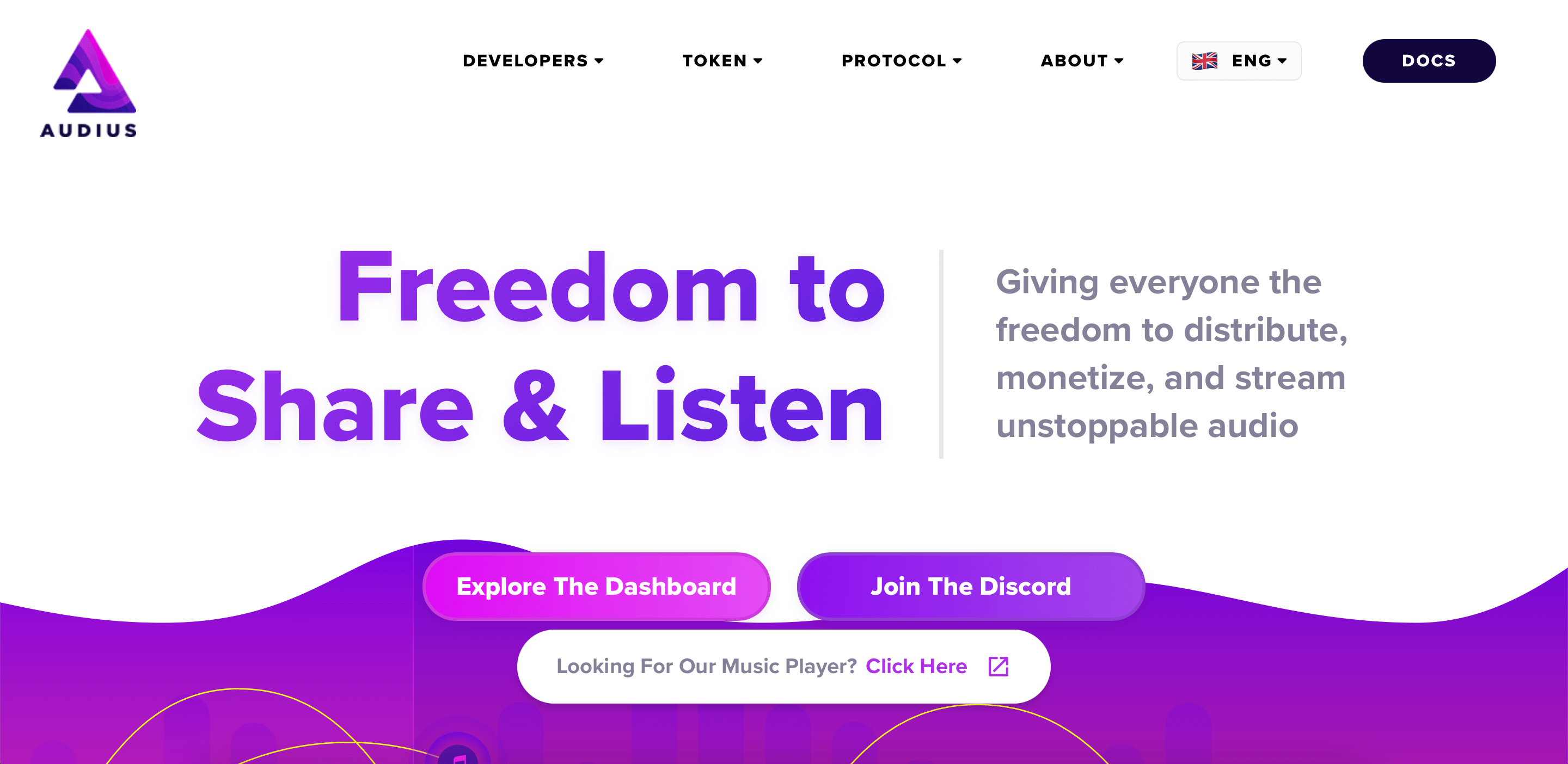
Audius is a decentralized blockchain-based music streaming platform with an open governance Audius has been officially launched in 2019 with a token sale. AUDIO is the native token of this platform. An initial 1 billion supply of AUDIO was distributed as follows: 36% — to investors, 41% — to founders, and the rest of the funds are spent on network growth. The AUDIO token is a payment method on the streaming service and is also used to incentivize network participation.
Today the token is worth $0.296 with a 24-hour trading volume of $8,070,787 USD. The total market cap is $242,261,964.99. In 2022 the price of the AUDIO token is predicted to reach a minimum level of $0.43, and an expected maximum level is $0.48.
At launch, the company received widespread support from those giants such as Twitch, EA Games, deadmau5. Such large centralized exchanges as Binance and Coinbase became Audius investors.
To become a music creator on Audius, a user have to register on the site and start distributing audio files through the AudSP protocol. Node operators, music creators, and users may propose and vote on changes to the protocol. There are Content Nodes in the Audius architecture, keeping data replicated and available.
This streaming platform allows not only musicians, but also users and node operators to earn money. Network participants are awarded for their involvement in staking, sharing music, and running the network.
In Q2 2021, Spotify took 31% of the music streaming industry, 15% went to Apple Music, 13% to Amazon Music. Audius offers a new approach to free music distribution and monetization of musicians' work.
Using a decentralized blockchain-based protocol, creators have complete control over the music they publish on the platform. The protocol solves a problem inherent in traditional music services that charge a significant percentage of revenue from music listening.
In 2021, Audius became one of the partners of the rapidly growing social network TikTok worldwide. Currently, the streaming service's collection consists of over 100,000 artists, among which there are such famous creators as Skrillex, Weezer, Diplo, and others.
Mask Network is a decentralized web extension that brings privacy and benefits from Web3 to social media like Facebook & Twitter.
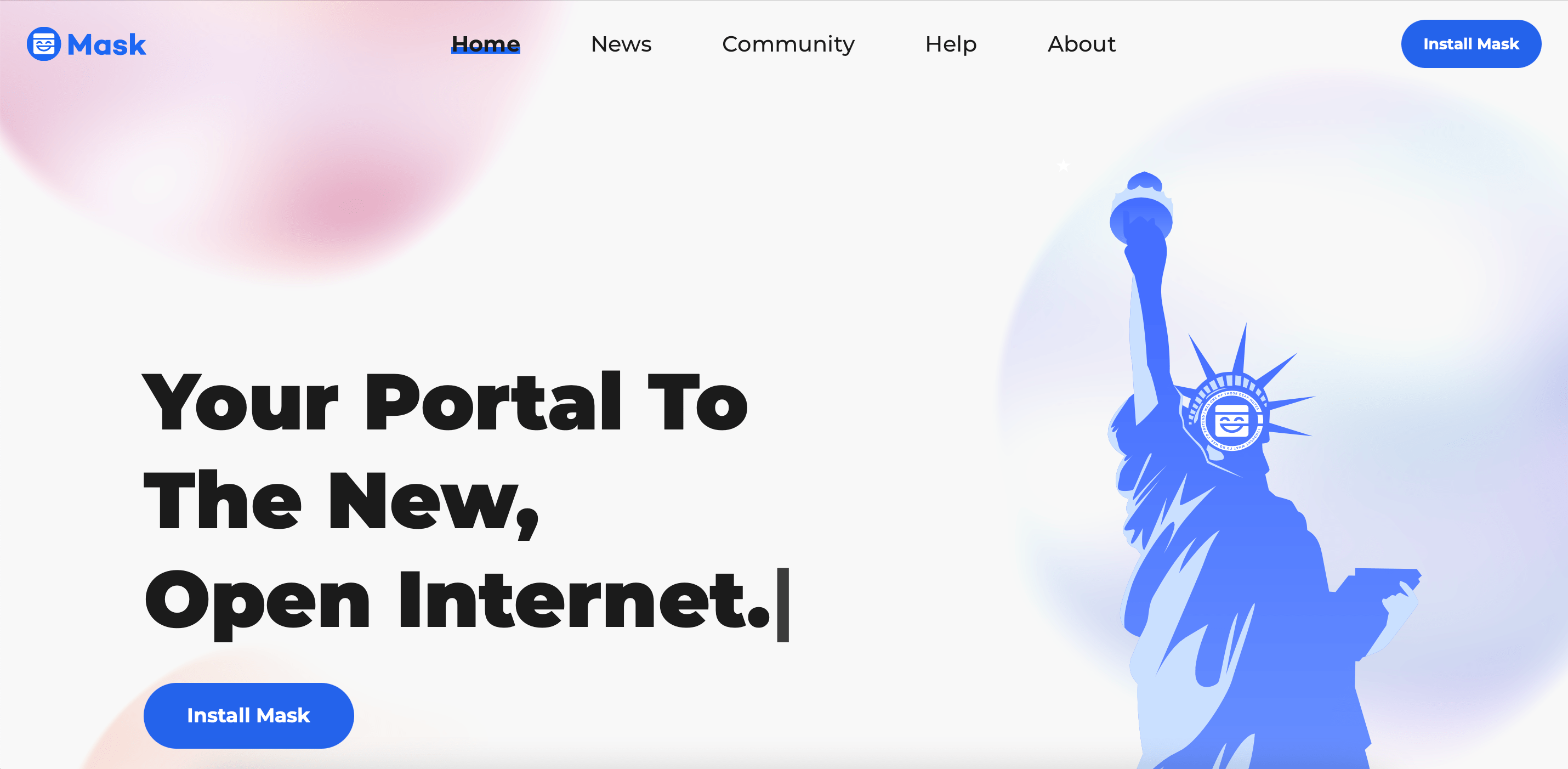
Mask Network is an Ethereum-based peer-to-peer app that serves as a bridge between the decentralized-blockchain solution and traditional social networks like Facebook, Twitter, and Minds. In the future, Mask is planning to support more networks.
The project launched in 2019, and the token sale finished in 2021. A total of 100,000,000 $MASK tokens were created at genesis. MASK is used primarily for governance (in MaskDAO, each token represents one vote). Token also used for protocol incentivization, DApplet development, and project extension.
$MASK token is worth $1.59 USD today with a 24-hour trading volume of $19,049,585 USD. At the start, the token was worth about $30. The highest growth was on April 1, 2021 - $MASK crossed the $25 threshold. Total Market Cap is $46,305,395.99.
The purpose of Mask Network is that the app allows users to send encrypted messages, cryptocurrencies, and DApps. Projects like Mask Network allow users to send payments, participate in public offerings, trade tokens, and access various other applications without leaving mainstream social media platforms.
The Mask Network creates a decentralized applet (DApplet) ecosystem. Applets are small applications performing simple functions built into the traditional Web 2.
The asymmetric encryption used in the portal architecture implies the existence of two keys - the public key for encryption and the private key for decryption. Just as, let's say, MetaMask developers do not have access to users' wallets, the Mask Network creators do not have control over your data. All control is yours.
The peculiarity of this portal's approach is that it creates a space for the privacy of social and commercial interactions where centralized authorities like Facebook would normally collect our personal information.
Installing Mask Network will take you a few minutes. The application is available for Google Chrome and Chromium-based browsers like Brave, Mozilla Firefox, and iOS & Android.
Conclusion
It's fair to say that Web 3.0 isn't without flaws either, and unfortunately, it's not technical flaws but an attempt to replicate the old governance structures and ways of exploiting users. Some well-known personalities from the industry are talking about this. For example, Jack Dorsey, ex-CEO of Twitter, recently made a provocative statement about the future of the Web 5.0 project.
Web 5.0, leapfrogging the era of Web 4.0, will provide a decentralized Internet layer based on Bitcoin's lightning network, according to Dorsey. However, this is a completely different story, deserving a separate review.
Web 3.0 is not a finished utopian project, however, many developers around the world are striving to make our everyday digital space more decentralized, secure, and censorship-resistant.
bitoftrade represents the values of decentralization as an anonymous non-custodial trading platform with unique and advanced trading tools.
Hurry up to use all the benefits of Web 3.0 and trade with us!
Join our social media channels to see more:
